
Seasonal in October
British Produce


Imported Produce


Vegetables, Fruit and Nuts
Vegetables
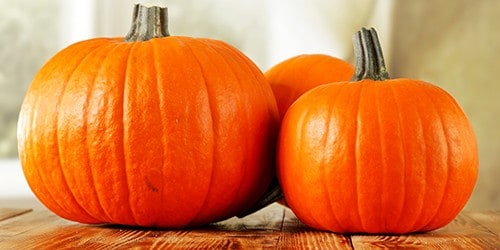
PUMPKIN:
At its best: September to November
A pumpkin’s flavour mostly depends on how it is cooked. Overall, it has a sweet, rich, and nutty taste – but when it’s cooked it brings out a sweet potato flavour, whereas roasting pumpkin produces a nuttier flavour. Drizzled oil, spices, onions, and garlic go great with cooked pumpkin.
Chef Suggestions: You can enjoy pumpkin when roasted, pureed, blended through a soup, or put through pasta. Try pairing pumpkin with risotto combined with sage, butter, and parmesan.
We recommend: Pumpkin can be used as a wonderful velvety velouté, to be served as a starter or as a rich sauce on your autumn menu. Alternatively, you can use the seasonal vegetable to prepare a sweet pumpkin pie with cinnamon.
Flavour pairings: Hard cheeses, sage, rosemary, chilli, chestnuts, cinnamon, nutmeg, shellfish, goat’s cheese, and almond.
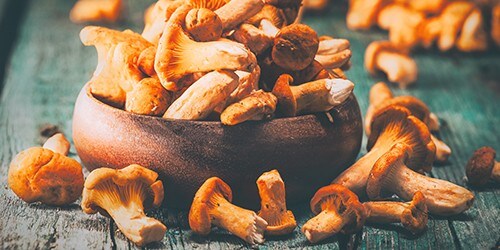
WILD MUSHROOMS:
At its best: September to December
Mushrooms have an earthy, meaty, or woodsy flavour, but the richness of these flavours varies depending on the type of mushroom. For example, button mushrooms are great sautéed or grilled and put in sauces, salads, or as pizza toppings – their subtle flavour matures when cooked. However, portobello mushrooms are great meat alternatives due to their size, meaty taste, and steak-like texture. There are so many varieties of mushrooms, but most will go well with garlic, thyme, butter, or parmesan.
Chef Suggestions: Wild mushrooms are great simply sauteed in butter, garlic and parsley paired with pasta and risotto.
We recommend: Great as a plant-based garnish adding a variety of textures to your dish.
Flavour pairings: Cheeses, rosemary, thyme, chicken, guinea fowl, beef, egg, bacon, pancetta, tarragon, apricot, and garlic.
Fruit and Nuts
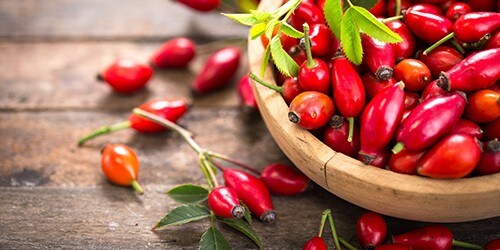
Rosehip:
At its best: October (After the first frost)
Rosehips are the fruit of the rose plant and are commonly used in teas, jams, and other culinary applications. They have a tangy and slightly sweet flavour, with a hint of floral notes.
Chef Suggestions: First, rinse well and remove any leaves or stems. It’s recommended to cook the rosehips in water over low heat for about an hour until they’re soft. Afterwards, you can press the cooked mixture through a fine sieve to remove the seeds and skin. The resulting mixture should be passed at least once through a muslin to remove the very fine hairs in the flesh, which can irritate the mouth and digestive tract if not removed. At this stage, it will have a wonderful deep red colour, and by adding lemon juice, you can help preserve its vivid red colour instead of turning reddish-brown.
You can then use this base to make jams, jellies, syrups, and vinegar.
We recommend: The best time to forage for them is right after the first autumn frost, when the sugar content is at its highest. You can find rosehip all over the countryside and parkland.
Flavour profile: Floral, slightly sweet and tart
Flavour pairings: Oranges, lemons, grapefruit, apples, cinnamon, ginger, pork, beef, chocolate, almonds, hazelnuts, walnuts and vanilla.
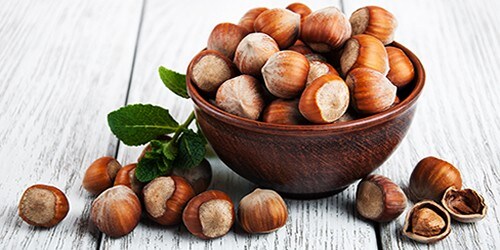
Hazelnuts:
At its best: September and October
Hazelnuts are a versatile and delicious ingredient in cooking and baking. They can add both crunch and flavour to dishes, including salads and roasted vegetables. Additionally, they can be ground into a paste to enhance sauces or desserts. Hazelnuts pair particularly well with chocolate, and are a common ingredient in pralines, truffles, and other confections. To roast hazelnuts, spread them out on a baking sheet and bake in a preheated oven at 180°C for 10-15 minutes, or until the skins start to crack and the nuts are lightly golden. Rub the nuts in a clean tea towel to remove any loose skin before using.
Chef Suggestions: In addition to being eaten raw or roasted, chopped hazelnuts can be added to cakes, cookies, and crumble toppings to add a nutty crunch. They can also be ground into a fine flour and used as a gluten-free alternative to wheat flour in baking, making it a popular choice for those with dietary restrictions. Additionally, hazelnuts can be used as a key ingredient in making homemade nut butter or as a topping for salads and savoury dishes.
We recommend: Ready-shelled hazelnuts stored in airtight packaging have a longer shelf life compared to hazelnuts in their shells, which may go rancid more quickly despite their aesthetic appeal.
Flavour profile: Sweet and mellow, rich buttery
Flavour pairings: Apple, apricot, avocado, banana, blackberry, broccoli, brussels sprouts, cherry, fig, grape, guava, Jerusalem artichoke, nectarine, orange, peach, pear, persimmon, plum, pumpkin, chestnuts, Brie, goat cheese, caramel, chocolate, coffee, duck, miso, salmon, turkey, and vanilla.
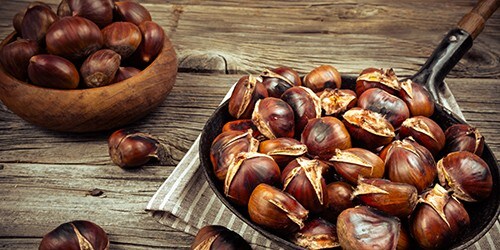
Chestnuts:
At its best: October – December
Their soft texture and strong flavour make them suitable for both sweet and savoury recipes. Chestnuts are slightly sweet and nutty, along with a starchy texture that is similar to potatoes. They are high in dietary fibre, packed with vitamin C, potassium, magnesium, copper, antioxidants, amino acids and essential fatty acids, making them a fantastic addition to any dish. These versatile nuts can be cooked in many ways. One popular method is roasting them over an open flame or in the oven, which enhances their natural sweetness and gives them a crispy texture. Chestnuts can also be boiled, steamed, or sautéed, and they work well in sweet or savoury dishes. They pair well with ingredients such as mushrooms, sage, rosemary, and onions, making them a great addition to stuffing, soups, and stews. Chestnuts can also be used in desserts, such as cakes and pastries, adding a unique nutty flavour and texture to the dish.
Chef Suggestions: To incorporate chestnuts into stuffing, begin by peeling and chopping them before adding to the mixture. For soups and sauces, peel the chestnuts and simmer them for 25 minutes. Then, puree them in a food processor. To create a sweet puree, add some sugar and use it to fill meringues or add to cake mixes. For fully roasted chestnuts, leave them in the oven for 15-25 minutes (as opposed to just 15 minutes for peeling), then peel and toss them in butter. This makes a perfect side dish to serve with Brussels sprouts.
We recommend: Choose raw chestnuts those with shiny, tight, dark brown skin and that feel firm and are heavy for their size.
Flavour profile: Sweet and crumbly, nutty
Flavour pairings: Pork, beef, chicken, mushrooms, sage, rosemary, brussels sprouts, chocolate, ricotta, goat cheese, Gorgonzola, apples, pears, figs, rice, and quinoa.













